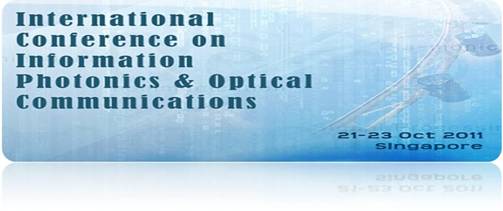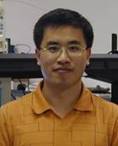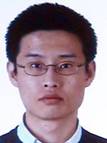IPOC 2011- Pre-conference Tutorial on 20th Oct 2011
SHUM Ping Perry (Prof)
This pre-conference tutorial is free. However, registration is needed due to limited seats available.

http://www.ipoc.co/
Pre-conference Tutorials ( 20th Oct 2011 )
In conjunction with the IPOC 2011@Singapore conference there will be 3 tutorials opened to the public on Thursday 20th October 2011.
The tutorials cover a diverse range of topics relevant to both industry and research in both the Information Photonics and Optical Communications.
Tutorials will be conducted at the School of Electrical & Electronic Engineering in NTU.
~~~~~~~~~~~~~~~~~~~~~~~~~~~~~~~~~~~~~~~~~~~~~~~~~~~~~~~~~~~~~~~~~~~~~~~~~
Venue: Executive Seminar Room (S2.2-B2-53) , Nanyang Technological University, Singapore 639798
Location map: http://maps.ntu.edu.sg/maps#q:EEE
Registration: https://wis.ntu.edu.sg/pls/webexe/REGISTER_NTU.REGISTER?EVENT_ID=OA11100321243074
~~~~~~~~~~~~~~~~~~~~~~~~~~~~~~~~~~~~~~~~~~~~~~~~~~~~~~~~~~~~~~~~~~~~~~~~~
Synopses of the Tutorials are given below.
Time: 2:30~3:30pm
Title: Polarization in Fiber Optics (IEEE Photonics Society Distinguished Lecture)
Abstract: Polarization is a paradoxical parameter in optical fiber, as it provides flexibilities in various applications, such as advanced modulation formats in optical fiber communication systems, polarization-assisted fiber sensor applications, sensitivity-enhanced biomedical applications, etc. On the other hand, polarization is difficult to control and even associated with signal degradations due to random and dynamic polarization evolutions along the fiber. Currently polarization-related impairments are among major hurdles for high performance fiber systems.
Tremendous efforts to effectively and efficiently manipulate polarization have been spent within the research and industry community. Starting from basic introduction about polarization, the lecture reviews different perspectives of polarization in fiber optics, including the polarization division multiplexing, polarization-related degrading effects and their mitigations, polarization based fiber sensor and biomedical applications, as well as polarization in nonlinear signal processing schemes. Practical issues will be highlighted.

Bio: Lianshan Yan (S’99–M’05–SM’06) received B.E. and Ph.D. degree from Zhejiang University (Hangzhou, 1994) and the University of Southern California (USC, Los Angeles, 2005), respectively. He has worked on solid state laser in North China Research Institute of Optoelectronics from 1994 to 1999. He has been with General Photonics Corp. as the chief scientist and manager of Engineering (2005-2007). He is currently a full professor and the director of Center for Information Photonics & Communications (CIPC) at Southwest Jiaotong University, Chengdu, Sichuan, China.
Prof. Yan is the author and coauthor of more than 200 papers published in prestigious journals and conference proceedings, including four invited journal papers and more than ten invited talks. He also co-authored two book chapters. He serves as a frequent referee for about twenty journals and holds twelve issued U.S. patents.
Prof. Yan is a senior member of the IEEE and a member of the Optical Society of America. He is one of the recipients of LEOS Graduate Fellowship in 2002, and the co-chair or TPC member of more than ten international conferences. He is an associate editor of IEEE Photonics Journal.
Time: 3:30~4:30pm
Title: The Review of Group Velocity Dispersion Control in Optical Fibres
Abstract: Group velocity dispersion (GVD) is the phenomenon that the group velocity of light in a transparent medium depends on the optical frequency or wavelength. GVD is one of the most important parameters in optical fibre design. It is responsible for various optical phenomena including dispersive temporal broadening or compression of ultrashort pulses, nonlinear pulse shaping and supercontinuum generation, and interaction bandwidth of different parametric nonlinear processes. In this tutorial, we will not only review the importance of GVD in various applications but also review the different means of GVD control in fibre design.

Bio: Dr. Luan is currently an Assistant Professor in the School of Electrical and Electronic Engineering, Nanyang Technological University. Dr. Luan obtained his BSc. and MSc. degrees in Physics from Peking University in 1999 and 2001 respectively. He joined the photonics material group of University of Bath and received PhD degree in 2005. At Bath he developed his expertise in design and fabrication of many kinds of microstructured optical fibres, including the first all solid photonic bandgap fibre (PBGF). He also investigated nonlinearities in different types of fibres which lead to the demonstration of high power soliton transmission in a hollow-core PBGF and the cancellation of soliton self-frequency shift in fibres with a negative group velocity dispersion slope. After PhD, he continued his research at Bath as a postdoc for one and half year. Then he joined the ARC Centre of Excellence for Ultrahigh-bandwidth Devices for Optical Systems at University of Sydney as a research fellow in 2007. At Sydney he focused on the research of high speed optical signal processing using high nonlinear planar waveguide and demonstrated ultrahigh bandwidth (3THz) RF spectrum measurements using photonics means. He has authored and co-authored more than 30 journal papers which attracted over 860 citations. Currently his h-index is 14. His current research interests include micro-cavity enhanced nonlinear Optics; photonic crystal fibres and their applications; and silicon photonics.
Time: 4:30~5:30pm
Title: A Scalable and Flexible Optical Switch Architecture for Future Data Centers
Abstract: The modern data center is a very important infrastructure that can support a large number of distinct services in the Internet. With the explosive growth of the data traffic, heat dissipation and power consumption have become the major issues in limiting the scalability and capacity of a data center. Optical switch fabrics with high port count is a promising solution for constructing large-scale and high-capacity data centers with low power consumption. However, an optical switch fabric that can support thousands of ports is difficult to achieve with current mechanical optical switches due to their high cost and low switching speed. In this tutorial, we introduce a scalable switch architecture for future large-scale data centers that is based on wavelength-routing and high-speed high port count optical cross-connects. Compared to the other proposals, the switch fabric has superior port-count scalability and low power consumption. Both physical and traffic performance of the switch fabric have been investigated through experiments and simulations. The results show that the switch fabric can support up to a thousand ports without traffic performance deterioration.

Bio: Dr. Yong-Kee Yeo (杨永祺博士) received his Bachelor’s Degree in Electrical and Electronic Engineering (with highest honours) from the National University of Singapore and his PhD degree in Electrical and Computer Engineering from Georgia Institute of Technology. From 1999-2002, he worked in A*STAR’s Institute of Microelectronics where he was involved in the electromagnetic modeling of signal interconnects and power distribution networks for multi-GHz microprocessors. He is now a Program Manager in A*STAR’s Institute for Infocomm Research and he oversees more than 15 research projects in the area of communications, high definition multimedia systems, and bio-sensing. Dr. Yeo is a recipient of A*STAR’s National Science Scholarship and he is also appointed to Singapore’s Telecommunication Standards Technical Committee in 2008. He has filed more than 15 patents in US and Singapore and has authored more than 50 publications in the field of optical fiber communications.
IPOC2011
International Conference on Information Photonics & Optical Communications (IPOC), Singapore, 21-23 October 2011 Please visit
http://www.ipoc.co
CONFIDENTIALITY: This email is intended solely for the person(s) named and may be confidential and/or privileged. If you are not the intended recipient, please delete it, notify us and do not copy, use, or disclose its content.
Towards A Sustainable Earth: Print Only When Necessary. Thank you.
